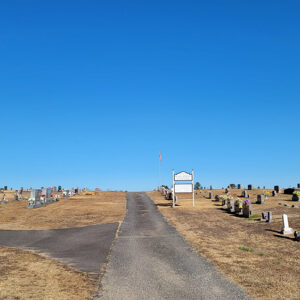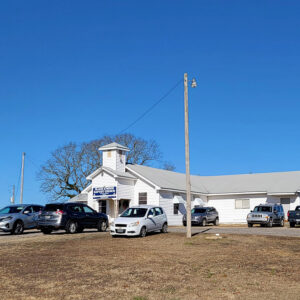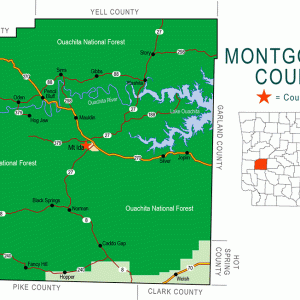calsfoundation@cals.org
Black Springs (Montgomery County)
| Latitude and Longitude: | 34°27’40″N 093°42’46″W |
| Elevation: | 774 feet |
| Area: | 0.45 square miles (2020 Census) |
| Population: | 96 (2020 Census) |
| Incorporation Date: | October 26, 1936 |
Historical Population as per the U.S. Census:
|
1810 |
1820 |
1830 |
1840 |
1850 |
1860 |
1870 |
1880 |
1890 |
1900 |
|
– |
– |
– |
– |
– |
– |
– |
– |
– |
– |
|
1910 |
1920 |
1930 |
1940 |
1950 |
1960 |
1970 |
1980 |
1990 |
2000 |
|
– |
– |
– |
– |
– |
– |
72 |
92 |
97 |
114 |
|
2010 |
2020 |
|
|
|
|
|
|
|
|
|
99 |
96 |
|
|
|
|
|
|
|
|
Black Springs is a town on State Highway 8 in Montgomery County. Surrounded by the Ouachita National Forest, Black Springs had the potential to be one of the larger communities in the county until the planned railroad failed to be built through the town.
Members of the Caddo Nation were living along the Caddo River when white settlers first arrived in the area. The springs for which the town was named were surrounded by black rocks—perhaps an ore of manganese or iron, or both. Also, a family named Black camped by the springs for a while. Either may have been the source of the name.
A road connecting Hot Springs (Garland County) to Dallas (Polk County) ran east and west past the springs, crossing the road that ran north to Mount Ida (Montgomery County) and south to Langley (Pike County). A Baptist church, one of the oldest such churches west of the Mississippi River, was established near the crossroads and springs in 1836. James Jeffrey claimed land west of the springs in 1848, and Jefferson Bates became his neighbor in 1855. A post office was established at Black Springs in 1869, and William B. Seay claimed land around the springs in 1876. Sarah Seay was the first postmaster for Black Springs.
By 1884, Black Springs was home to two doctors, a dentist, a druggist, and a lawyer. There were two churches—Baptist and Methodist—and several stores. A school district was established in 1886, supported by a tax base of sixty-three families. The population has been estimated at 250 residents at that time. A newspaper called the Black Springs Herald was published by J. M Raines beginning in 1880. In 1896, John Middleton and Jesse Irby quarreled over a fence line and property rights, fighting a duel in which Irby was killed. The Fort Smith and Gurdon Railway surveyed a route through the area late in the nineteenth century, but the railroad was never built.
By 1900, the community had a post office, a public school, a spring house and bath house, several mills, and a park. A cotton gin, powered by oxen, had also been built. The Black Springs school hosted a two-week teacher training academy (known then as a “normal school”) each summer. The community had a Masonic lodge and a lodge of the Independent Order of Odd Fellows (IOOF), as well as two hotels and two saloons. William Rowton established the Black Springs–Caddo Valley Bank in the early twentieth century. In 1907, the bank was robbed, and the thieves blew up the building.
Ingram Lumber Company, based in Kansas City, Missouri, leased large swaths of land in the Black Springs area and formed the Black Springs Lumber Company. For a while it appeared that the railroad, planned earlier by the Fort Smith and Gurdon Railway, would be built by the Missouri Pacific Company through Black Springs, eventually extending to Fort Smith (Sebastian County). A dispute over right-of-way, however, diverted the line to the east. By 1907, when it became evident that the railroad was not going to reach Black Springs, the Black Springs company relocated to Womble—later renamed Norman (Montgomery County)—though the company kept the name Black Springs until it closed its last mill in 1925.
Boyd Anderson Tackett was born in Black Springs in 1911. A few years later, he and his family moved to Glenwood (Pike County). Tackett represented the Fourth District of Arkansas in the U.S. House of Representatives from 1949 to 1953.
As Womble/Norman grew due to the lumber industry, Black Springs remained a smaller agricultural center. Since the late nineteenth century, farming in the area had been diversified, featuring cotton, tobacco, and assorted vegetables. The Black Springs School District consolidated with that of Norman in 1929, but a new school building was built in Black Springs in 1932. The building was used as a school until 1955, when a new school was built in Norman. Black Springs was incorporated as a town in 1936. Three men from Black Springs died while serving in the armed forces during World War II. The post office was closed in 1980. By 1986, Black Springs had only the Baptist church and a community center building. The town’s population in 2010 was ninety-nine, all of whom were white.
For additional information:
The Goodspeed Biographical and Historical Memoirs of Western Arkansas. Chicago: Southern Publishing Company, 1891.
Montgomery County Historical Society. Montgomery County Our Heritage. 2 vols. Mount Ida, AR: Montgomery County Historical Society, 1986, 1990.
Steven Teske
Butler Center for Arkansas Studies
 Black Springs
Black Springs  Black Springs Cemetery
Black Springs Cemetery  Black Springs Church
Black Springs Church  Black Springs City Hall
Black Springs City Hall  Black Springs Street Scene
Black Springs Street Scene  Black Springs Street Scene
Black Springs Street Scene  Montgomery County Map
Montgomery County Map 




Comments
No comments on this entry yet.